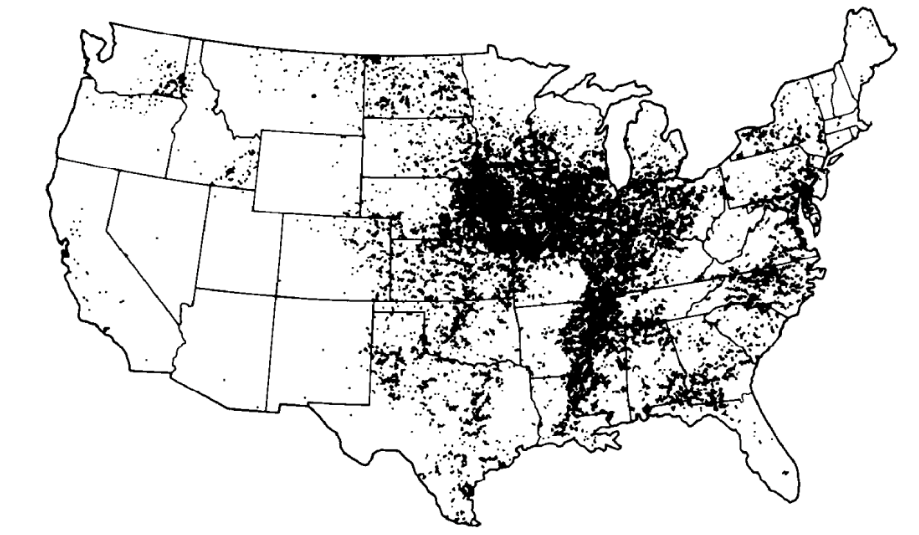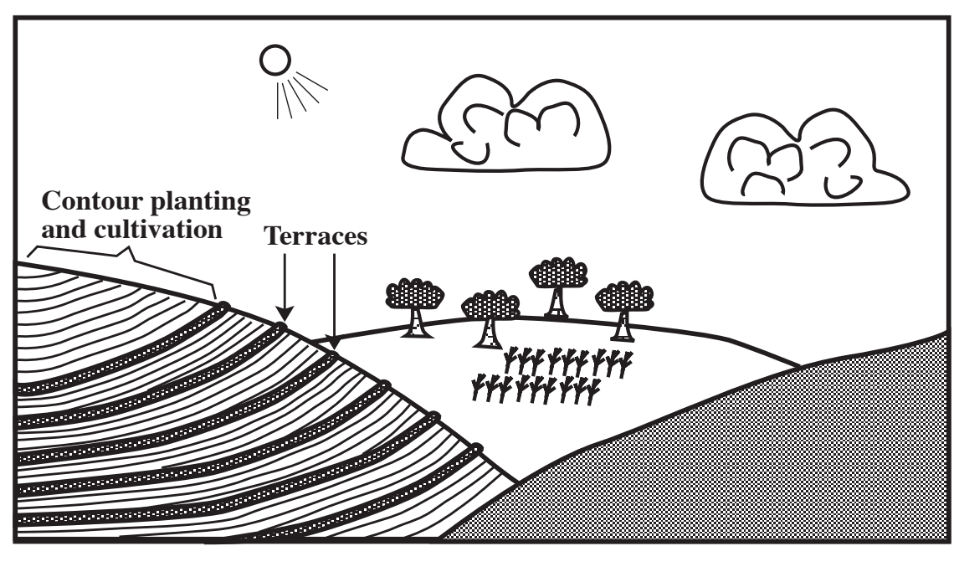11.11: Soil Loss - Desertification and Deforestation
- Page ID
- 285702
Soil erosion refers to the loss and relocation of topsoil by water and wind action. About a third of U.S. topsoil has been lost to erosion since cultivation began on the continent and at present about a third of U.S. cropland is eroding at a rate sufficient to lower productivity. About 10% of U.S. land is eroding at an unacceptable rate in excess of 14 tons of toposil per acre annually. Soil erosion is largely a product of cultivation. Except in cases of extreme slopes, very high winds, and torrential rains, uncultivated soils undergo little erosion. Erosion was recognized as a problem in the central United States within a few years after forests and prairie grasslands were first plowed to plant crops, particularly in the latter 1800s. The recognition that precious topsoil was being lost at an unsustainable rate lead to soil conservation measures going back to 1900, or even earlier. In that sense, soil conservation was the first environmental movement, predating efforts to alleviate water and air pollution by many decades.
Water erosion is responsible for greater loss of soil than is wind erosion. Whereas wind erosion tends to move soil around and deposit it in areas where it can still be used for growing crops, water erosion normally moves greater quantities of soil and carries them into streams and rivers and ultimately to the oceans. The overall pattern of soil erosion in the Central Continental United States is shown in Figure 11.5. This figure shows that erosion is especially bad in agricultural areas draining into the Missouri and Mississippi Rivers; millions of tons of soil are carried by these rivers into the Gulf of Mexico each year. These are areas of relatively high rainfall, which can sometimes come as very intense rainstorms, especially during the spring. A high proportion of the farmlands in these areas are devoted to row crops, which are crops such as corn, soybeans, and sorghum grains planted in rows with bare soil in between. This mode of cultivation leaves soil that is especially susceptible to water erosion.

The ultimate result of soil erosion and other unsustainable agricultural practices in relatively dry areas is desertification. This condition occurs when permanent plant cover is lost from soil so that it loses its capacity to retain moisture, dries out, and loses fertility so that plants no longer grow on it. Among the interrelated factors involved in desertification are wind erosion, water erosion (which occurs during sporadic cloudbursts even in arid areas), development of adverse climate conditions, depletion of underground water aquifers, lack of water for irrigation, accumulation of salt in water supplies, loss of soil organic matter, and deterioration of soil physical and chemical properties. Eventually the land becomes unable to support agriculture, grazing, or even significant human populations. Desertification is one of the most troublesome results of global warming caused by greenhouse gases. It is actually a very old problem and is a serious concern in many parts of the world, such as the Mideast, the southern boundary of Africa’sSahara, and regions of the southwestern U. S. Formerly productive areas of the Middle East and North Africa, “lands of milk and honey” described in biblical terms, have turned into desert, largely due to human agricultural activities. The growth of domestic grazing animals on these areas — especially goats, which tend to pull vegetation up by its roots — has been a particularly strong contributor to desertification. Much of the productive capacity of arid grasslands in the western and southwestern United States has been drastically diminished by overgrazing.
Fortunately, human ingenuity and technological tools can be used to prevent or reverse desertification. For example, water, which upon occasion falls as torrential rain upon normally dry desert lands, can be collected and used to recharge underground water aquifers. Advanced cultivation and irrigation techniques can be used to establish perennial plant cover on erosion-prone desert soils. Potentially, plants can be genetically engineered to grow under severe conditions of temperature, drought, and salinity. Environmentally friendly mining practices can be employed to obtain minerals, and land surfaces damaged by harmful strip mining practices can be restored.
The loss of forest growth to cultivated land —deforestation— has occurred extensively in the United States. However, much of the colonial U.S., particularly in New England, which was deforested for cultivation of crops, is now undergoing largely spontaneous reforestation as unprofitable farmlands are abandoned and trees become established again. Deforestation is a particularly severe problem in tropical regions. Rich tropical forests contain most known plant and animal species many of which are becoming extinct as the forests are destroyed. Once destroyed, tropical forests are almost impossible to restore. This is because tropical forest soil has been leached of nutrients by the high annual rainfalls in tropical regions. When forest cover is removed, the soil erodes rapidly, loses the plant roots and other biomass that tends to hold it together, loses nutrients, and becomes unable to sustain either useful crops or the kinds of forests formerly supported.
The key to preventing soil loss from erosion as well as preventing desertification from taking place lies in a group of practices that agriculturists term soil conservation. A number of different approaches are used to retain soil and enhance its quality. Some of these are old, long-established techniques such as construction of terraces and planting crops on the contour of the land (see Figure 11.6). Crop rotation and occasional planting of fields to cover crops, such as clover, are also old practices. A relatively new practice involves minimum cultivation and planting crops through the residue of crops from the previous year. This practice, now commonly called conservation tillage, is very effective in reducing erosion because of the soil cover of previous crops and the roots that are left in place. Conservation tillage does make use of herbicides to kill

competing weeds until the desired crop is established enough to shade out competing plants, but only minimum quantities of herbicides are applied. There is some concern that fungi (molds) will thrive in old crop residues and cause problems with new crops.
The ultimate in no-till agriculture is the use of perennial plants that do not have to be planted each year. Trees in orchards and grape vines in vinyards are such plants. The roots of perennial plants are very effective in holding soil in place. Efforts to develop perennial plants that produce grain have not been successful to date. This is because a successful grain-producing plant is one that dedicates its metabolic processes to the production of large quantities of seed that can be used for grain, whereas perennial plants put their energy into the development of large, bulbous root structures that store food for the next growing system. It is possible that sometime in the future genetic engineering may be applied to the development of perennial plants capable of producing high grain yields.
Among the most successful plants at stopping erosion are trees. These plants grow for many years and some tree varieties will grow back from their root structures when the wood is harvested. Wood and wood products are probably the most widely used renewable resources. Hybrid tree varieties have been developed that are outstanding producers of biomass.
Wood is a renewable resource used for many purposes. In construction, wood substitutes for steel, aluminum, and cement. All of these materials are produced by very energy-intensive processes, so substitution of wood, where applicable, conserves large amounts of energy. Wood is about 50% cellulose, a carbohydrate polymer that is used directly to make paper. Although humans and many other animals cannot use cellulose directly for fuel, it can be broken down chemically or biochemically to glucose sugar. This material serves as a food source for yeasts (a form of fungi) that generate ethanol, an alcohol that can be used as fuel and to make other chemicals. In the process, the yeasts produce protein that can be fed to animals.
Biochar for Soil Conservation and Enrichment
A relatively recent development in enhancing soil quality is the use of biochar as a soil amendment. Biochar is made by the pyrolysis of organic matter such as crop residues. It is a natural constituent of soil as the result of forest and prairie fires, but is now produced artificially for addition to soil.1 The two major advantages of biochar are its high affinity for nutrients by adsorption and its extremely high persistence; unlike humic material it never degrades. Furthermore, the production of biochar has the net effect of permanently sequestering atmospheric carbon dioxide fixed by photosynthesis thus helping to alleviate global warming.
Water and Soil Conservation
Conservation of soil and conservation of water go together very closely. Soil is normally the first part of the geosphere that water contacts, and contaminated soil yields contaminated water. Most fresh water falls initially on soil, and the condition of the soil largely determines the fate of the water and how much is retained in a usable condition. Soil in a condition that retains water allows rainwater to infiltrate into groundwater. If water drains too rapidly from soil, the soil erodes and the water runoff is badly contaminated with soil sediments. Measures taken to conserve soil usually conserve water as well. Terraces, contour cultivation, constructed waterways, and water-retaining ponds (Figure 11.6) prevent water from washing soil away, but also retain water and help prevent flash floods. Some of these measures, especially terracing, involve modification of the contour of the soil. Bands of trees can be planted on the contour to retain both soil and water. Reforestation of land unsuitable for growing crops and avoiding practices, such as overgrazing, that tend to lead to desertification conserve water as well as land.


